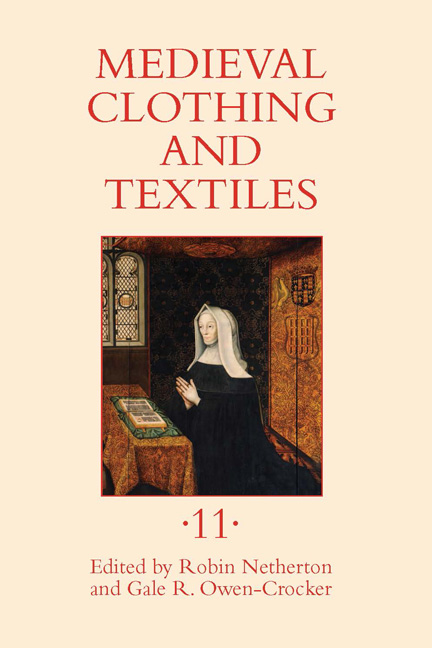Book contents
- Frontmatter
- Contents
- Illustrations
- Tables
- Contributors
- Preface
- 1 Production, Quality, and Social Status in Viking Age Dress: Three Cases from Western Norway
- 2 The Effect of Spindle Whorl Design on Wool Thread Production: A Practical Experiment Based on Examples from Eighth-Century Denmark
- 3 The Shirt Attributed to St. Louis
- 4 Angevin-Sicilian Sumptuary Statutes of the 1290s: Fashion in the Thirteenth-Century Mediterranean
- 5 The Devil on My Tail: Clothing and Visual Culture in the Camposanto Last Judgment
- 6 “Transposing þe shapus þat God first mad them of”: Manipulated Masculinity in the Galaunt Tradition
- 7 Textiles and Dress in the Household Papers of Lady Margaret Beaufort (1443–1509), Mother of King Henry VII
- 8 “Like two artificial gods”: Needlework and Female Bonding in A Midsummer Night's Dream
- Recent Books of Interest
- Contents of Previous Volumes
1 - Production, Quality, and Social Status in Viking Age Dress: Three Cases from Western Norway
Published online by Cambridge University Press: 05 December 2015
- Frontmatter
- Contents
- Illustrations
- Tables
- Contributors
- Preface
- 1 Production, Quality, and Social Status in Viking Age Dress: Three Cases from Western Norway
- 2 The Effect of Spindle Whorl Design on Wool Thread Production: A Practical Experiment Based on Examples from Eighth-Century Denmark
- 3 The Shirt Attributed to St. Louis
- 4 Angevin-Sicilian Sumptuary Statutes of the 1290s: Fashion in the Thirteenth-Century Mediterranean
- 5 The Devil on My Tail: Clothing and Visual Culture in the Camposanto Last Judgment
- 6 “Transposing þe shapus þat God first mad them of”: Manipulated Masculinity in the Galaunt Tradition
- 7 Textiles and Dress in the Household Papers of Lady Margaret Beaufort (1443–1509), Mother of King Henry VII
- 8 “Like two artificial gods”: Needlework and Female Bonding in A Midsummer Night's Dream
- Recent Books of Interest
- Contents of Previous Volumes
Summary
Textiles have been, and continue to be, indispensable necessities, but they are also able to signify status. In Norway, traces of textiles and textile production become especially apparent in the Viking Age (ca. 800–1050) through the burial custom of inhumation graves, where the deceased were buried according to their rank, and in women's graves, in their dress, with dress accessories and often with textile tools among the grave goods. In some cases there are still traces of clothes—representing one of the few find contexts with preserved textiles from this period in Norway. As concrete remains of products and means of production in different work processes, these finds throw light upon both clothing and textile production in the different physical and socioeconomic environments in which they were found. Differences among regions and districts can prove to be significant indicators of underlying social and economic trends. The evidence for special-quality textiles in relatively limited geographical zones and within a period of major transformations, politically, economically, and socially—such as Christianization, state formation, and early urbanization—makes this an interesting issue to investigate. This article discusses how and to what degree textile fragments and textile tools from female burials can illuminate quality, status, and level of textile production. The environments in which finds from Western Norway appear and the degree to which they reflect local textile production will be assessed. The study relates to an ongoing research project on textile production in this region in the Viking Age and the Middle Ages.
The primary research area is the central part of Western Norway, consisting of the three medieval fylki (counties) of Hordal-and to the south, with the only town in the region, Bergen, from the late eleventh century; Sogn, further north along the 200-kilometer-long Sognefjord; and north of that, Fjordane (the fjords). The area stretches from the North Sea coast to the inner fjord districts and mountainous areas (see fig. 1.1).
- Type
- Chapter
- Information
- Medieval Clothing and Textiles 11 , pp. 1 - 28Publisher: Boydell & BrewerPrint publication year: 2015



